I am in a show at the Neuberger Museum in Purchase with cardboard jewelry I made in the early 80’s.
Here is a link to an article in the NY Times about the show.
News and more
I am in a show at the Neuberger Museum in Purchase with cardboard jewelry I made in the early 80’s.
Here is a link to an article in the NY Times about the show.
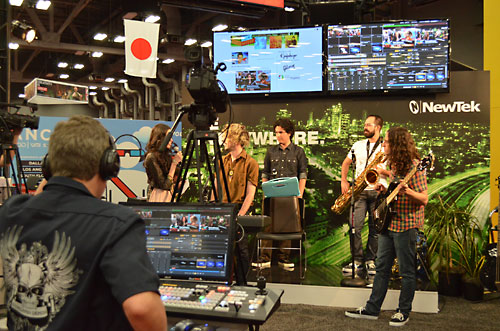
I headed for The Right Tool for the Job: Native or Mobile Web? Developers from Facebook, Tumblr, Ember.js and Webkit discussed when it was appropriate to choose to develop apps in the native environment (they were primarily discussing apps for iOS), when web based apps are a better choice. There was also a discussion of the pros and cons of hybrid apps, using the Facebook app as the primary example. The panelists stressed that you get a lot for free with browser based apps, and that monetization is the primary reasons for creating a native app (you can find/sell it in the app store). They seemed to generally agree that content heavy apps might be better served in the browser development model. The development cycle for web based apps was compared to the cycle for native apps- it is much faster to develop a web based app. There was a plea for developers to get involved in the W3C rather than simply complain about their slow progress.
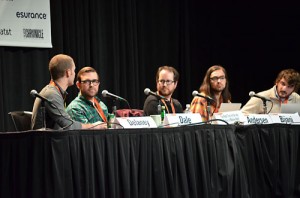
Flash: F Bomb or Da Bomb. This panel examined issues that Flash has with accessibility and also with search engine optimization. Panelist Philip Gross described how difficult/impossible it is to use a screen reader with a site built completely in Flash. Kristine Schachinger, who tests government sites for accessibility, suggested using Flash for small parts of a site, not building out a whole site in Flash because of SEO problems, as well as accessibility. There was some criticism of Adobe for not dealing with these issues. Also a plea to make sites more accessible, not just to “do the right thing”, but as a business decision. Sites that are not accessible are losing a lot of business. The future of Flash was seen in offline applications, such as kiosks, AIR desktop applications.
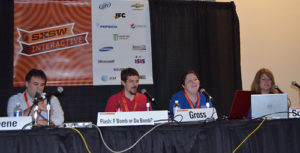
In Coding the Next Chapter of America History Jennifer Pahlka of Code for America described her project of getting developers and programmers into local government to create apps and technologies. She quoted former boss Tim O”Reilly “Government is a platform.”Code for America has a fellowship program, now in its second year, which places developers in local government. Pahlka described the growing pains of setting this program up, as well as demoing a couple of projects that have been built, including Adopt-a-Hydrant, an app that helped users in Boston identify snowed in fire hydrants during a snowopocalypse so they could go dig them out. She also announced the launch of Code for America Brigade, a platform for organizing citizen hackers: “Change your community through software”.
I considered going to the Anthony Bourdain panel, until I saw the huge line of people waiting to get in and decided my panels were over for this year.
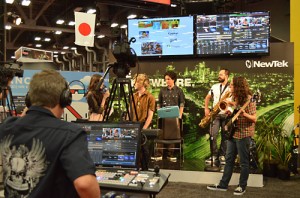
Calvin and I walked the floor of the trade show during the block party, free food and beer, and plenty of swag. Calvin won a tee-shirt with his wicked fast typing skills. They eventually gave me one too, just for hanging around.
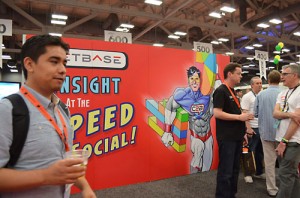
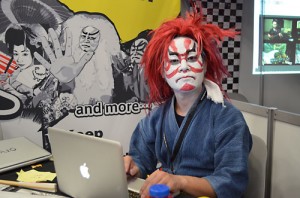

The first panel I made it to was Designing Games for Documentary. This panel had members from academic programs (USC primarily), as well as artists, developers and designers. They demoed a range of games, covering topics such as cleaning up wall street, gender inequity, murder investigations, and platforms including board games, iOS and web based games. Peter Brinson stressed that a more important question than genre was whether one was working in the short or the long form. “All media makers should be interested in the short form. A short leaves them wanting more.” Tony Walsh demoed a non-fiction game his company had created where the user lived in a neighborhood and became involved in local issues, such as a garbage strike, and tried to convince others of his or her point of view. The player wins by convincing people their position is the correct one. “A person with more facts is a better negotiator, which is not necessarily true in real life”. Cindy Poremba demoed her iOS game Grime, which replicates the experience of a grafitti artist who washes part of a wall rather than writing on it.
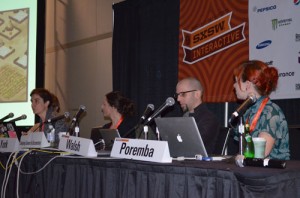
Next up Jaron Lanier interviewed by Nicholas Thompson of the New Yorker Is Technology Making Our Lives Richer or Poorer?. Thoughtful and provocative. He started by playing a strange Darth Vader like instrument. They discussed his recent op-ed piece in the New York Times. “I am not anti-Facebook, I celebrate their success. However it becomes an act of will to avoid it.” “Facebook is not an open forum, there are rules and your data is not owned and controlled by you. Right now its ok, maybe not later.” (Interestingly, I posted a link to the controversial op-ed piece- on Facebook!) “No technology can foster creativity and relationships. There are always real people behind the curtain”. Lanier also talked about the problems that may be looming when more people lose their jobs because of technology. “Cars driving themselves – good, people are terrible drivers but lots of people will lose their jobs. Manufacturing will also go away, 3D printers are cool. There are many benefits, but what do we do with the people who lose their jobs?”
“Aristotle talks about the day when the machines get really good- we can free the slaves”. According to Lanier, Henry Ford understood that you have to grow the whole economy- the people who make the cars have to be able to buy the cars as well.
Lanier proposes that the industry needs to develop a universal commerce model rather than the current walled garden model. “monetize information to empower people.” Both the model of (anonymous) 4chan and (you must say who you are) Facebook are wrong. “People have to both own their own information and they should be able to reinvent themselves”.
I may come back to this post later to make it more than a series of quotes- this was an interesting conversation, not just a bunch of rambling thoughts. But I have to get back to work! So more Jaron later.
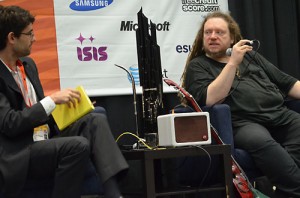

I listened to some of Ray Kurzweil’s keynote– it was interesting, but I was sleepy. What can I saw, it starts to get to you. Looking at my notes, he thinks Siri is pretty good (he helped develop voice recognition). He also emphasized the effectiveness of project based learning to teach kids.
Prototype vs. Sim: Validating Software & UX Design was frog design’s presentation on their approach to rapid prototyping. Jared Ficklin discussed the rise of the makers, with a shout-out to Cory Doctorow, and its influence on their process. Gregg Wygonik: “Making is designing.” “With desktop 3D printing, you can make anything”. “…convergence between digital and physical”. Robert Tuttle described the key proof of concepts needed in prototyping- perceptual, technical, logical and economic.
This too is available online as an audio file- visuals were great, but I am sure you can get the idea from tuning in.
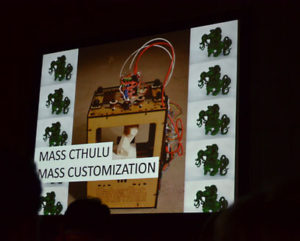
Finally, Al Gore and Sean Parker (of Napster fame) talking about social activism and social media. This seems to have been a bit of a last minute addition, in a gigantic packed hall that gave me flashbacks to the movie screening mega-room at Comic-con.
Another interesting conversation, though. Sean Parker, discussing the origins of his activist social media platforms which include Causes, NationBuilder and Votizen-“In 2006, I began to think why don’t any of these platforms DO anything?” Al Gore (citing Malcolm Gladwell) “There’s a tendency to think that if you get someone to point and click the ties are often weaker and less durable.” When Parker said “The change that we want to see is not going to come from Washington” Gore quickly spoke up “I can confirm that” and the crowd roared. Gore made a passionate plea for campaign financing reform: “75-80% of campaign financing spent on 30 second TV ads, and these are not the federalist papers.”
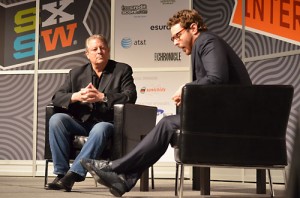

I missed The Future of HTML5 Motion Design– disappointed, but I had some stuff to do, including uploading way too many pictures to flickr and answering emails for work. Luckily, there is an audio recording, will check it out later.
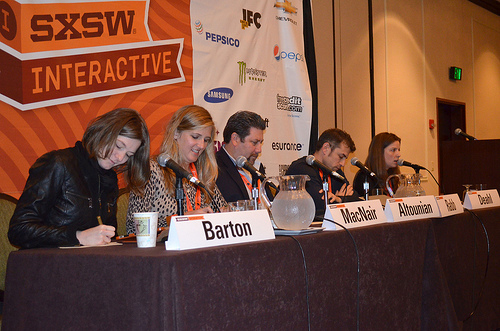
Both of the panels Calvin was involved with were on Sunday morning. We headed out to the convention center early, finally having amazing luck with the shuttle- it was waiting when we got downstairs at 7:30. Not the usual hour wait.
First panel: Publishing Models: Transforming the Book. Calvin was the organizer for this panel and Rachel Deahl, also of Publishers Weekly, moderated. I have to admit, I was furiously taking pictures, far more than could ever be used, so my notes are practically non-existent. Luckily, Calvin has written it up for PW, read SXSW 2012: New Publishing Models and the Rise of the Referral Economy The panel was lively, featuring among other highlights a spirited discussion of publishing models between Brian Altounian of Wowio and Molly Barton of Penquin.
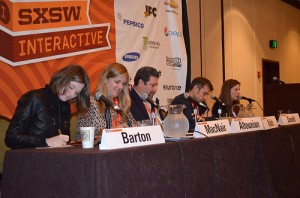
Calvin was the moderator of Discoverability and the New World of Book PR. This panel examined new marketing practices for selling books in the age of social media. All of the panelists agreed that there was no longer such a thing as local press because of the web. How do you convert an NPR interview into sales at Barnes and Noble? Barbara Henricks of Cave Henricks Communications pointed out that there is no custom template for marketing books. Rusty Shelton of Shelton Interactive stressed the importance of giving sufficient time to build a connection between audience and author, not a month before publication. Shelton- “Good PR helps bad books fail faster.”
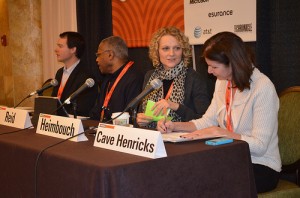
After these panels were over, we hooked up with my family for brunch. Fun! and I got to hang out with my great nephew Eamonn. And it was my birthday!
Back for more panels, first How Comics Journalism Is Saving Your Media. I particularly enjoyed this panel, as I am obviously a huge fan of non-fiction comics. Erin Polgreen talked about Symbolia, a tablet app of illustrative journalism that she has founded. Susie Cagle, who has a background in journalism, showed some of her coverage of Occupy Oakland. The panelists talked about how it is sometimes easier to convince a subject to let them draw a picture than to take a photograph. Matt Bors showed some pages from coverage of post-quake Haiti created by cartoonists and illustrators from Haiti. Heres a link to a live blog if you would like to read more, well worth it.
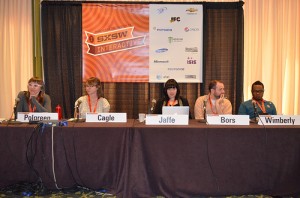
Final panel of the day, Reinventing the Graphic Novel for the iPad. Daniel Burwen discussed his evolution from game designer and animator to iPad/graphic novel designer and developer. His project CIA: Operation Ajax is a 210 page interactive graphic novel for the iPad. “I wanted to tell stories about other stuff than Tony Hawk.” He traced his influences from the world of graphic novels to Brian Michael Bendis’ book Torso- a thriller that “was like no comic I had ever seen”, with unusual layouts and graphic storytelling strategies. One of the lessons Burwen learned “Comics are artisanal”, a process quite different from game development. The project took 3 years to create a 210 page graphic novel and an interactive iPad app. Flash was used as the tool to mock up the app initially. The app has a lot of additional content, video, documents from the time period of the story.
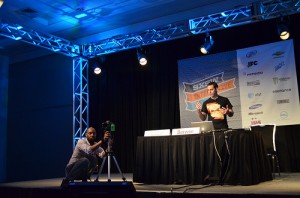
We dropped by a couple of publishing parties, then had dinner with some publishing people at a tasty sushi spot. And they sang happy birthday to me!
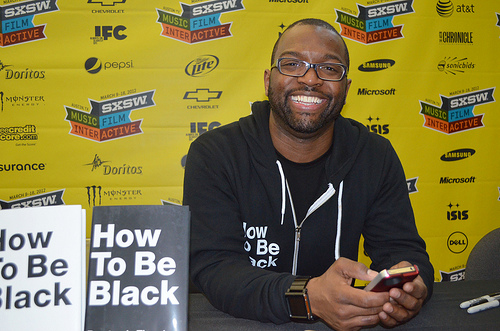
Grabbed a cab with very nice couple, including one of the panelists I saw the afternoon before, Charlie Wollborg. Shuttle nightmare continues, rainopocalypse also continues. Got to the convention center late, but made it to the end of browser debugging tools panel – The State of Browser Developer Tools. I missed most of the presentations, but heard the panelists wish for more interoperability between the tools, and that browser developers would work together to standardize the tools. Convergence! There is a W3C working group on this topic. “Ask for what you want! Make some noise! File a ticket on Bugzilla.” Another discussion was the lack of debugging tools for some of the HTML5 functionality, like web sockets and keyframe animations.
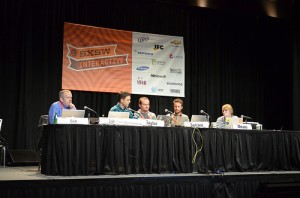
Best SXSW moment, running into a former student when she scanned my badge, she is an intern for SX and designed a lot of the graphics! Go Jessica Clark! She designed the logo for the SX cycles program sponsored by HBO, as well as a lot of the maps, which are awesome.
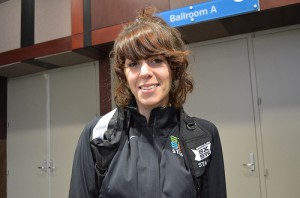
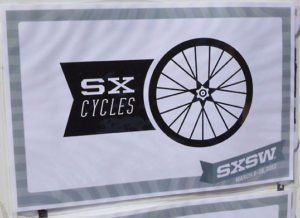
Next up, walked around a bit, then headed to the Top Chef Transmedia panel.Interesting to hear their strategy for “Last Chance Kitchen”, a side running series of webisodes, where recently eliminated chefs could fight to get back on the show. I am a big Top Chef fan, I enjoyed this panel a lot, and didn’t find Andy Cohen as irritating in person as I find him on TV. Weird. He was joined by Tom Colicchio, and producers and marketers of the show. Top Chef encourages all of their “cheftestants” to engage with the fans on twitter and other social media. Upcoming plans include incorporating content created by fans.
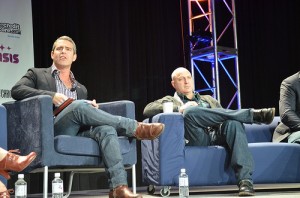
Listened to web standards evangelist Chris Mills of Opera at HTML5 and CSS3: Does Now Really Mean Now? He demoed some of the cool new features, then showed how to design so that the work would look good in browsers that do not yet support these features. “Progressive Enhancement”, “Don’t Rely on the Shiny” and “Graceful Degradation”- words to live by. He stressed the need to always have fallbacks or shims when necessary. He advised using Modernizr for feature detection. Most notable quote “Every time you use an IE filter a kitten dies.” This talk is available as an audio file on the link above, (some, but not all panels are recorded) definitely work a listen.
Baratunde Thurston’s keynote was entertaining and thoughtful. A funny man- what else would you expect from someone who works for The Onion and has written How To Be Black? His talk touched on the personal- stories from his mom and grandmother’s lives, illustrated by great photos. Cool apparently peaked in 1964, if you were wondering. He spoke about growing up in Washington DC: “We had everything they had in The Wire in my neighborhood except universal acclaim and the undying love of white people.” He showed images and clips of comedians throughout the world, including Nigeria and Iran, taking on the political situation in their country, critiquing it with humor, and using social media to get keep pushing.
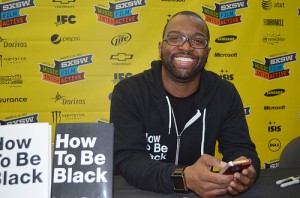
We headed up to the Sheraton to The Curators and the Curated panel. Interesting discussion – what is aggregation and what is curation? When a person selects and recommends, it is curation, when an algorithm does it, it is aggregation? David Carr of the NY Times was ferociously articulate, I kind of agreed with him when he said the word curation is kind of twee, but that this is a new type of cultural activity. Mia Quagliarello of Flipboard discussed their process of working with publishers to select, then reformat and paginate content, creating custom templates. Maria Popova of Brain Pickings has proposed a system for systematically identifying and attributing curated content that has just launched on Curator’s Code. Noah Brier of Percolate pointed out that “Brands are in the eco-system of content creation, for better or worse”. Interesting and thoughtful panel. And it is recorded, listen to it on the site.
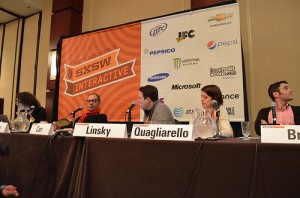
Dinner with the members of the Publishers Weekly panel. Delicious! I will always trust Rachel Deahl to pick a restaurant.
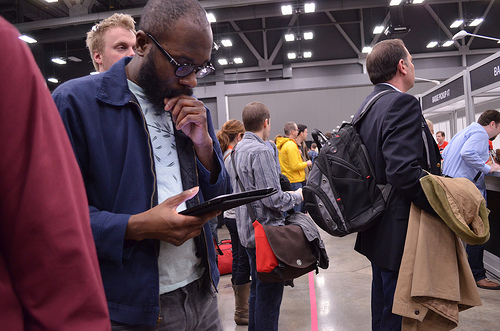
Got to Austin late, past midnight, and I still had to wait in long line for a taxi- our hotel is far, far away from the convention center, and far from the airport. jetBlue was fun, I enjoy channel surfing on the plane and eating blue potato chips. I believe I am the last person in the country who enjoys flying.
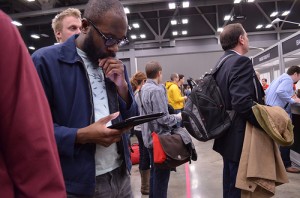
Much excitement getting to the convention center, and plenty of rain. After waiting in  line with many hundreds of people staring at their iOS devices (and noting that this crowd generally does not want to put their iPhones in cases), I got my badge in enough time to head out to O’Reilly’s TOC publishing mini-conference. Got very very wet on the way- yes that is a running theme this year at SXSW, sorry abut the whining.
I heard a couple of interesting presentations- Jason Illian demoing his project Book Shout centered on creating communities of readers who can share and comment as they read with many options to personalize their groups. There was a very amusing panel of authors, many from Texas, talking about how they used social media to connect with their audience. I was particularly interested in one of the books, Cooking For Geeks by Jeff Potter, which appropriately is an O’Reilly publication. (I bought it later at the convention center so I could get it signed by the author.) The science of cooking, but with real recipes- my kind of title.
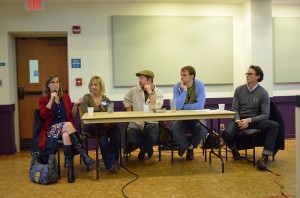
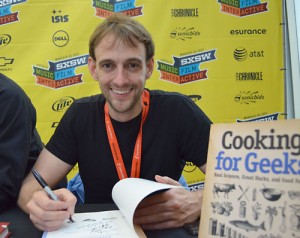
We braved the rain to walk to the Sheraton Austin, where most of the journalism/publishing panels are taking place. After a hearty buffet lunch, we saw Digital vs. Print:Storyboard to Digital Delivery. Many representatives of major media conglomerates, talking about “content is king”. Have we heard this before? Yes. Liz Schimel of Meredith National Media Group (publishers of magazines like Parents and Better Homes and Gardens) made some interesting comments on reaching the women in their audience and determining what kind of content and functionality they are looking for. She mentioned that women are often using their iPads while cooking (that would be me) and that they are learning from how their customers are leveraging technology.
The Power of Visual Storytelling was next, one of the most entertaining panels so far. The panelists seemed determined not to be another boring group of yammering talking heads. One of the panelists, Charlie Wollborg, jumped up from the podium and walked out into the audience to rant- think about what you are sharing. “Think WIST – Would I Share This?” “Instagram is killing storytelling.” What does literacy mean- “We should be teaching kids how to write  a good headline”. Another panelist, Karl Rude, spoke of the importance of design “the glue that holds everything together”, as well as the various forms of literacy, verbal, visual, theatrical and technical . I enjoyed this, and enjoyed watching the live stream of pro-panel and con-panel tweets flying behind them on a gigantic screen, but wished there had been a bit more specifics that had to do with visual storytelling. Entertaining though, and of course how can I not agree with advice to think more about design and literacy?
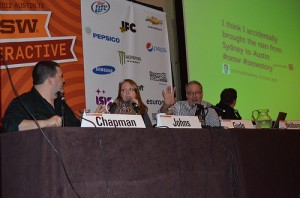
Next, MIT Media Labs. Joichi Ito, the director, gave an overview of their history and also of OUR history- before internet (B.I.) after internet (A.I.). A few quotes- “Media Lab is not directed research, it is anti-disciplinary.” Â “Our work is less about products, more about eco-systems”. They also demoed a few of the projects in the works. As always, fun to see what they are up to. One interesting project that Katharine Havasi was working on was getting computers to understand language the way people do, to be used to help doctors understand their patients better, giving feedback on their bedside manner.
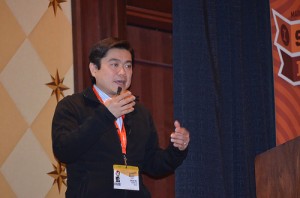
I slipped into the very end of what I found was the most interesting presentation so far- Designing Living Things, a group of engineers, designers and academics discussing synthetic biology. I only wish I had attended the whole thing. Christina Agapakis “As engineers, we are using evolution as a design tool”. Â Patrick Boyle- “We are in the process of developing standards and practices to fail gracefully”. Interesting discussion of spider-goats- spider silk is apparently one of the strongest materials around, there is interest in replicating it.
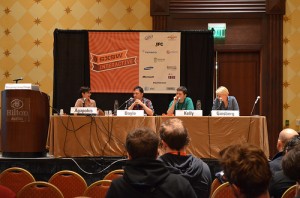
That was the end of my day of panels. Â Calvin and Rachel had a dinner, so I went back out to the hotel through yes, more rain. Got lots of work done, though, a bit boring.
Carriage Trade has a benefit up now, all of the works in the show are photos taken with cell phone cameras. Very nice exhibition, and you might want to buy a piece of reasonably priced art for someone you love! I have a piece here, as do many others near and dear to me.
I’m in Pop Patriotism at Carriage Trade on Walker St. This exhibition is a re-presentation of a show Peter Scott curated at Momenta one year after 9/11. It opens Thursday Sept.22. It was a great show then, it should be a great show now. I have photos in the show of the many flags that were everywhere in Manhattan (and in advertising campaigns) right after 9/11.